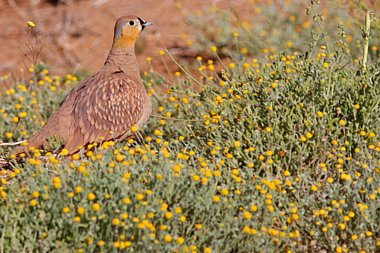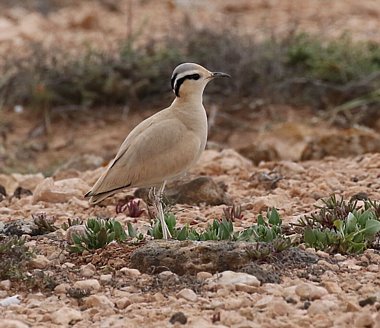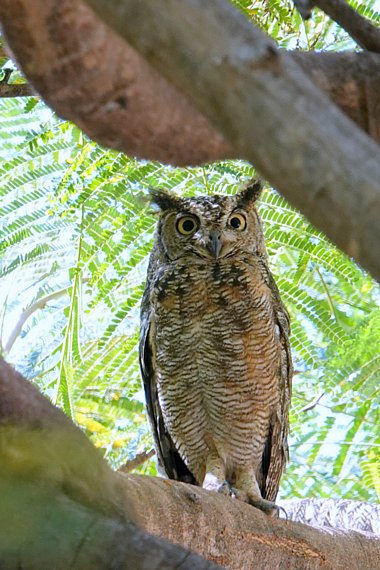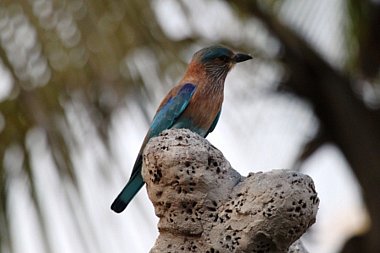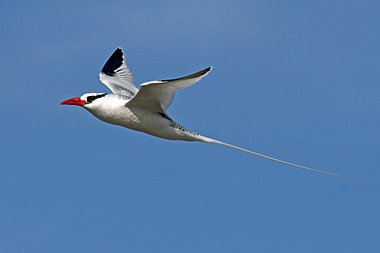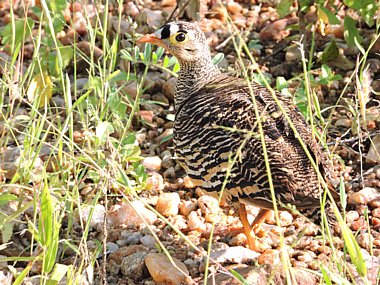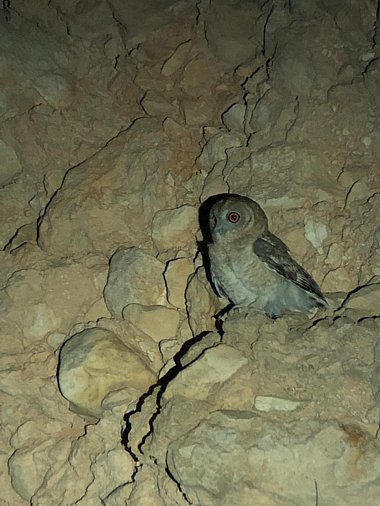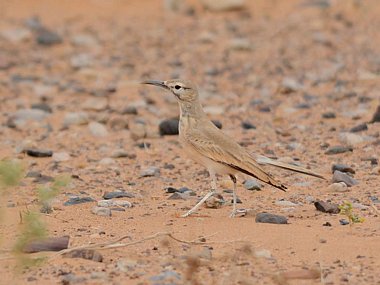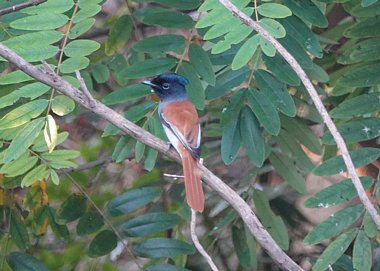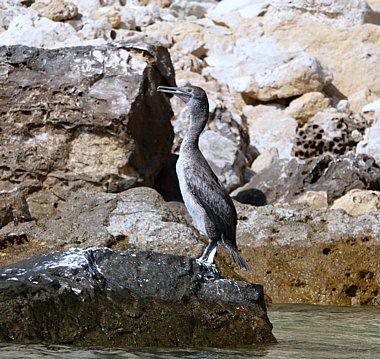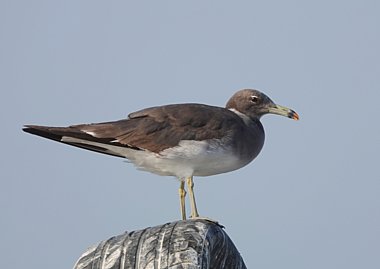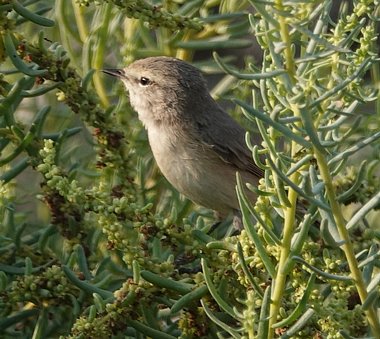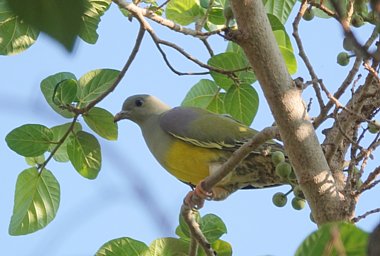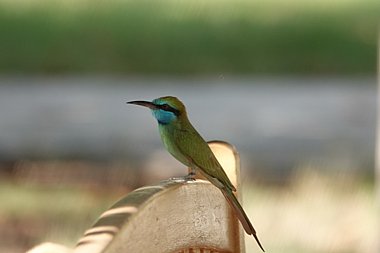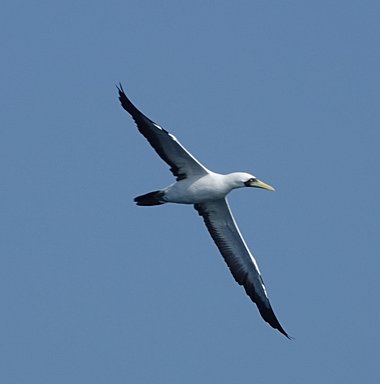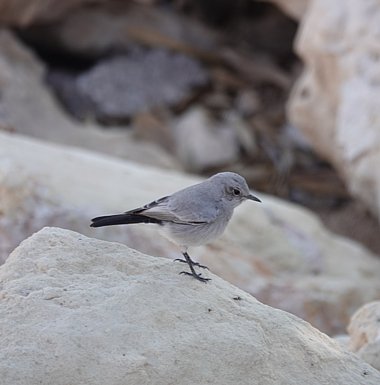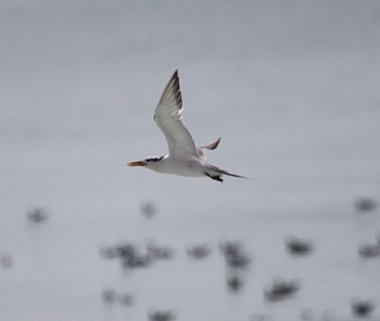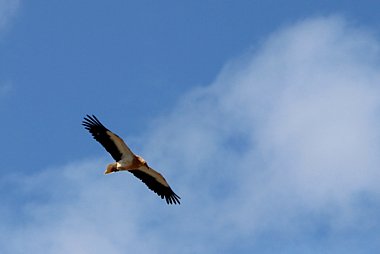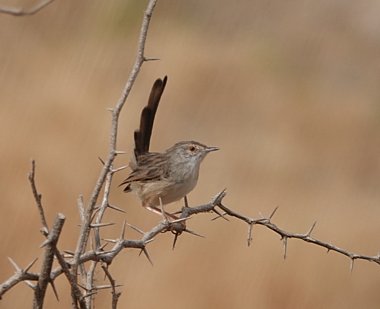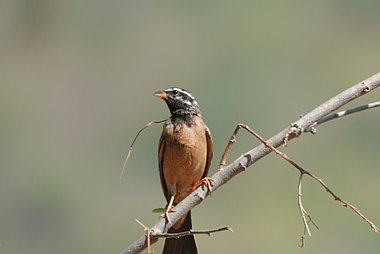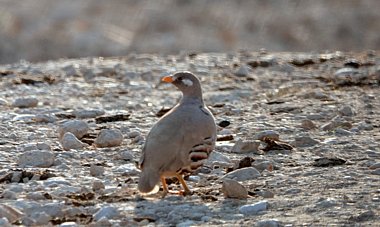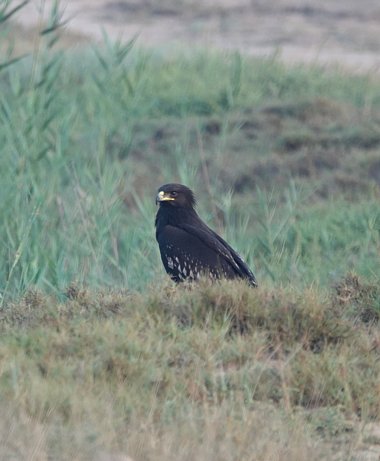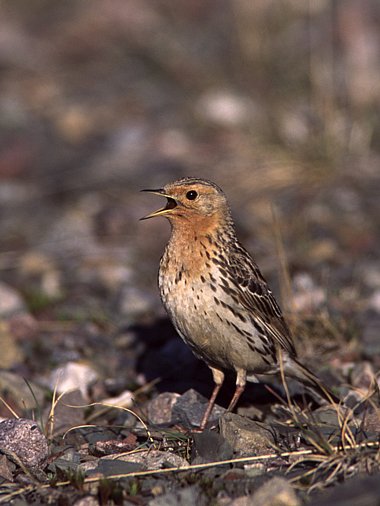NEW! Ultimate Oman
Spectacular birding at the crossroads of Europe, Africa and Asia.
| Destination | |
|---|---|
| Focus | |
| Max Group Size | 8 |
- Free Bird Guide
FREE copy of Birds of Oman with every room booked on this holiday.
- Enquire
At the edge of the Western Palearctic, the Sultanate of Oman is located at a crossroads between Europe, Africa and Asia and as a result, the birdlife is both diverse and surprisingly abundant given much of the country is made up of desert. On this detailed tour, we spread our time around three coastlines, visiting the rugged mountain and bleak desert interiors too. With spectacular and varied habitats including sandy beaches, lagoons, mudflats, agricultural fields, sand dunes, stony desert and mountains, such diversity is reflected in the very special birds we will see.
We explore from Muscat, the capital in the north, through the Al Hajjar Mountain range to the wader filled east coast and Masirah Island, before briefly entering the ‘empty quarter’ and finishing in Dhofar region in the far south. The list of special birds on this journey is remarkable, perhaps including Sooty Falcon, Socotra Cormorant, Jouanin’s Petrel, Persian Shearwater, Oriental Honey Buzzard, Lappet-faced Vulture, Verreaux’s Eagle, Arabian and Sand Partridge, Crab Plover, Sociable Lapwing, Cream coloured Courser, Spotted Thick-Knee, Lichtenstein’s, Crowned, Spotted and Chestnut-bellied Sandgrouse, Forbe’s-Watson’s Swift, Bruce’s Green Pigeon, Nile Valley Sunbird, Grey Hypocolius, Hume’s, Persian and Arabian Wheatear, Singing Bushlark, Arabian Warbler, Arabian Golden-winged Grosbeak, Yemen Serin and many more possible, alongside Palearctic migrants and middle-eastern rarities
Oman recently hit the headlines among western birders with the discovery of a new species to science in 2013 - the Omani Owl. One of five possible owl species on this tour, we have deliberately extended our itinerary, assigning extra days to locations with the most birding potential and more time to recover after owling excursions. With scarce mammals including cetaceans with turtles possible too, a fabulous Arabian adventure awaits!
Enjoy your complimentary pre-flight overnight hotel before your holiday begins. Full details from our office! Read more about our Pre-flight Service here!
Day 1: Thur 23 October 2025 - UK- Oman
We fly London to Muscat overnight, arriving in Oman in the early hours of Friday morning and after breakfast and a little rest, board our vehicles and get straight into local birding.
Day 2: Fri 24 October - Al Qurm and Al Ansab
We begin our exploration at wetland and coastal sites close to Muscat where we have many good birding options. In a largely desert environment water of any sort warrants attention, and we investigate wetland sites and areas of coastline with beaches and offshore rocks. Al Qurm lies close to the city centre and offers a good mixture of such habitat, while the man-made lagoons while the sewage treatment plant at Al Ansab has been one of Oman’s premier birding destinations for decades! Across both sites we look for Striated, Indian Pond and Western Reef Heron, Spotted, Baillon’s and Little Crake, Garganey, Ferruginous Duck, Grey Francolin, Red-wattled Lapwing, Pin-tailed Snipe, Pacific Golden Plover, Marsh, Green and Wood Sandpiper and Little Stint. In surrounding scrub, Red-vented and White-spectacled Bulbul may both be seen, along with Little Green Bee-eater, Purple Sunbird, Citrine Wagtail, Bluethroat and Common Mynah. Scanning offshore, Slender-billed and Sooty Gull are likely roosting alongside White-cheeked, Whiskered, Sandwich, Lesser Crested and Greater Crested Tern. A great first day! Overnight Muscat area for four nights.
Day 3: Sat 25 October - Al Fahal Island
Lying 4km off the mainland, Al Fahal (or Shark) island is comprised of limestone some of which is believed to be over 50 million years old. An internationally important site for endangered Sooty Falcon, we take a boat trip out to the island to see the colony as their breeding season comes to an end. While much of the population has been in decline elsewhere, it has remained more stable on Al Fahal and with adults, and fledged youngsters on the wing we should be in for a real treat. There is also a chance of finding Persian Shearwater, Arabian Tropicbird, flocks of Red-necked Phalarope and if lucky, local Spinner Dolphin and Bryde’s Whale. Returning to land, we may choose to venture inland towards the desert and mountains for the first time. A waste disposal site attracts eagles and vultures, and though less active in recent years can still be good for Steppe Eagle with lesser numbers of Eastern Imperial and Greater-Spotted Eagle and Eqyptian Vulture. We may also see our first Hume’s Wheatear or Desert Lark while scanning the skies.
Day 4: Sun 26 October - Ras-as-Sawadi and Northern Al Hajjar Mountains
A morning visit to Ras-as-Sawadi will give us good coastal birding plus another chance for Sooty Falcon, which breed on the islands a few miles offshore. The promontory jutting out into the Gulf of Oman can boast the expected range of waders, gulls and terns while sea-watching from the point can have its rewards with passing Masked Booby or an early returning Pallas’s Gull. After some time on the north coast, we head inland and into the beautiful Al Hajjar Mountains to begin our search for its specialities. Entering the northern part of the range, Sand Partridge, Desert, Persian, Hooded and Hume’s Wheatear, (Eastern) Black Redstart, Eastern Orphean Warbler and Striolated Bunting may feature. Liechtenstein’s Sandgrouse are also possible, but it’s by night that these Mountains have achieved recent fame among western birders when in 2013 a new, undescribed species was discovered here – the Omani Owl! After time exploring the area by day, we return to our accommodation early and take a little time to relax before an (optional) night time excursion to search for this highly prized species! Pallid Scops Owl is also a target, while the local form of Little Owl (Lilith Owl – a potential split) may be encountered too.
NB: Omani Owl – This is a very difficult species, with just a tiny known population thus far and with much still to learn. By visiting known Wadi’s deep into the central Al Hajjar Mountains, we hope to hear the birds calling, and subsequently track them to obtain a sighting but there are no guarantees. Night-time excursions may last for several hours, and we may well attempt to try and find them on more than one night. All such excursions are of course optional.
Day 5: Mon 27 October – Al Batinah coast or Muscat region
With extremely changeable habitats, and many locations influenced so greatly by the presence (or lack of) water, no one tour to Oman can ever be the same! As such, we keep one day in the north flexible with options to explore the Al Batinah coast as far as the UAE border, or to re-visit hotpots around Muscat. The far north-west was formerly a stronghold for Collared Kingfisher (of the kalbaensis subspecies), Variable Wheatear and Syke’s Warbler – all scarce Omani species. And while observations have declined to a point where they have been absent for many years, still being present across the border all three have shown signs of (at least sporadically) returning. Also possible around Al Batinah are waders, gulls, terns and passerines such as Black-crowned Sparrow Lark, Arabian Babbler, Graceful Prinia and Clamorous Reed Warbler. With such varied birdlife, whatever we decide to do on this day new species are still likely, while the extra time also allows for more leisurely days after evening owl sessions.
Day 6: Tue 28 October – The Southern Al Hajjar Mountains
Today we transfer into the southern part of the Al Hajjar Mountains, birding as always along the way. Among the species likely at roadside stops are Sand Partridge, Namaqua Dove, Desert Lark, Long-billed Pipit, Streaked Scrub Warbler, Persian and Hooded Wheatear, Turkestan and Daurian Shrike. Arriving in the mountains, time spent close to our accommodation late-afternoon may prove productive for raptors including Lappet-faced and Egyptian Vulture, Bonelli’s, Short-toed (scarce) and Great Spotted Eagle. After dark we take further (optional) excursions for target owls if required. Overnight Nizwa for 2 nights.
Day 7: Wed 29 October - Sayq Plateau
The Sayq Plateau was formerly one of the highest and most inaccessible inhabited regions in Oman. In more modern times, a tarmac road allows access to the top and we spend a leisurely day exploring the remote, stunning landscapes of the Al Hajjar range, slowly checking orchards and scrub around the villages and sheltered Wadi’s along the 32km stretch of road. Any small pools can attract wintering migrants including Asian scarcities and a few Plain Leaf Warbler occur in the orchards alongside Pale Crag Martin, Hume’s Wheatear, Striolated Bunting and Blue Rock Thrush in more open ground. The rare Arabian Tahr, endemic to the mountains of Northern Oman, still occurs as does Arabian Gazelle and Arabian Wolf, though all three mammals are endangered and elusive.
Days 8 & 9: Thur 30 & Fri 31 October – Barr Al Hikman and Masirah Island
Leaving the mountains and heading south-east, we expect to arrive at Barr Al Hikman after lunch, where the vast coastal mudflats stretching to Masirah Island really are THE wader mecca of Oman! One of the most important coastal wetlands in the world, over 50 species of wader have been recorded and among the many thousands of birds present. Depending on tides, light conditions and favoured feeding areas, we give plenty of time to check through the masses properly over several days, both here and on Masirah Island. On our arrival, there may be time to visit a couple of the mainland viewpoints to scan the flocks before taking our evening ferry onto the island, where we stay overnight at the Masirah Luxury Resort for two nights.
Stunning Crab Plover are our primary target, while we also search for Greater and Lesser Sand Plover, Kentish Plover, Marsh, Broad-billed and Curlew Sandpiper, Little Stint alongside huge numbers of more familiar UK species. Groups of Greater Flamingo and Spoonbill draw the eye, flocks of gulls may include Heuglin's (Siberian) and Caspian Gull, a regular flock of White-cheeked Tern can exceed 50,000 individuals and Osprey and Pallid Harrier are just two of the possible raptors. Access to the tidal bays can often be better from Masirah side than on the mainland and the numbers of waders and terns can even higher and we deliberately take our time here exploring the area fully to appreciate the spectacle!
The island is also something of a migrant trap, and after poor weather in autumn falls of passerines may occur. Among the commoner species, recent scarcities have included Great Snipe, Wryneck, Olive-backed Pipit, Black-throated Thrush and Red-breasted Flycatcher. Masirah has also been one of the most regular sites in Oman for wintering Asian Koel in recent years too. As well as being great for birds, the island is also a sea turtle breeding ground of global importance for four species - Loggerhead, Green, Hawksbill and Olive Ridley.
Day 10: Sat 1 November – Barr Al Hikman and south to Duqm
After taking the ferry back to Shannah, we could take a few more hours enjoying the waders at Barr Al Hikman again. Depending on the tides, different view options may be available to the south as Film and we may well add new species such as Great Knot or Terek Sandpiper. Being an area so famous among birders, any patches of coastal scrub and parkland are now regularly turning up migrants which has only enhanced the areas reputation! If time allows, we can search the cover, while a nearby wadi can attract Chestnut-bellied and Spotted Sandgrouse if retaining water. On site vegetation here can support migrants too and after some time birding, we make inroads into the journey south by driving to Duqm, where we stay for one night.
Day 11: Sun 2 November - The East coast
Our longest driving day, we work our way down Oman’s east coast where new roads allow us to explore areas often neglected. While traveling is the priority, we do have birding options and will plan a few stops to help break up the journey. Khawr Dhuf is a rarely visited gem and likely stop, which alongside expected waders can yield surprises including Pin-tailed Snipe. Khawr Gawri is another similar option, and with the Arabian sea ever present as we follow the coast south, gatherings of gulls, terns and Masked Booby are likely anywhere offshore. At Ash Shuwaymiyyah we may have time for birding too, the Wadi being one of the most beautiful in all of Oman. With a good road into its heart, it has become known as a good site for Liechtenstein’s Sandgrouse with Tristram’s Starling, Shining Sunbird and Arabian Wheatear also possible. The pools and tidal lagoons can be good for waders and the area is famed for large numbers of roosting Socotra Cormorant. We may also get lucky and encounter the resident pod of Indopacific Bottlenose Dolphin before continuing our journey inland. Overnight Thumrait for two nights.
Day 12: Mon 3 November - Muntasar and Qatbit
Known as the ‘Empty Quarter’, Oman’s vast desert interior still supports a range of specialist species. while any trees and habituation act as an oasis for migrants. We start the day early, driving north to Muntasar where a dawn visit may yield Chestnut-bellied, Crowned and Spotted Sandgrouse coming into drink. Migrants may be found in the bushes, Greater Hoopoe, Bimaculated, Short-toed Lark and Oriental Skylark in more open ground, while raptors including Golden Eagle and Pallid Harrier are possible. Within such an extensive desert, the trees, shrubs and bushes at Qatbit can attract even more migrants and the site has a superb reputation for Asian rarities. Chiffchaff and Lesser Whitethroat are often numerous, and other species could include Turtle and Oriental Turtle Dove, Bluethroat, Rufous-tailed Scrub Robin, Tree and Olive-backed Pipit, Siberian Chiffchaff, Barred, Yellow-browed and Hume’s Leaf Warbler and Red-breasted Flycatcher.
Day 13: Tue 4 November - Mudvay Oasis and Thumrait
Mudvay is rapidly becoming the ‘go to’ place in Oman for several key, 'Empty Quarter' species. Our main target will be Grey Hypocolius, and by visiting a small park early in the morning we have a good chance with regular sightings in recent years. Nile Valley Sunbird, African Collared Dove, Sand Partridge and Asian Koel are also possible too, and local standing water can attract sandgrouse. After the morning here, we return to Thumrait farmland for waders, perhaps including Sociable Lapwing and Cream-coloured Courser, a variety of pipits, larks and wheatears. Later we travel south to the city of Salalah, where we stay overnight for four nights.
Day 14: Wed 5 November – Eastern Dhofar
The Dhofar region in southernmost Oman is a wonderful area, supporting many of the countries specialities and offering superb birding. There are many great sites, and we will likely begin with those to the east of Salalah. We look for Arabian Golden-winged Grosbeak, a key but difficult target which may require more than one attempt. At a nearby site we search for Yemen Serin, the huge sink-hole here is perhaps more impressive than this drab coloured finch Also on this day, we may encounter Bonelli’s Eagle, Bruce’s Green Pigeon, Arabian Warbler, Abyssinian White-eye, African Paradise Flycatcher, Black-crowned Tchagra, Graceful Prinia, Tristam’s Grackle, Rüppell’s Weaver, Blue Rock Thrush, Palestine Sunbird and African Rock Bunting – a great days birding! And there’s more to come, as we stay into the evening or re-visiting after dinner for Arabian Scops Owl and Arabian Eagle Owl - two key birds of the Dhofar region.
Day 15: Thur 6 November - Mirabat pelagic
The pelagic trips into the Arabian Sea from Mirbat are legendary for close views of seabirds, of tricky to see Jouanin’s Petrel especially. With unrivalled views of Persian and Flesh-footed Shearwater, Bridled, Great and Lesser Crested Tern, Masked Booby and busy flocks of Red-necked Phalarope likely too, plus occasional Green and Loggerhead Turtle and cetaceans including Sperm Whale, it is certainly a boat trip not to be missed!
After our pelagic, we may head to a mountain viewpoint (if not already visited the day before) for sought-after Verreaux’s Eagle. A range of other locations holding water on the south coast can be good for waders including Little Pratincole and Black-winged Stilt, with Yellow Bittern, Pheasant-tailed Jacana, Grey-headed Kingfisher, Baillon’s and Little Crake, Yellow-billed Kite and perhaps Oriental Honey Buzzard. In the evening, an optional after-dinner excursion to search for Desert Owl (our fifth and final owl target) will likely be offered.
Day 16: Fri 7 November - Salalah and Western Dhofar
The Al Balid Archaeological site is one of the most reliable locations for Spotted Thick-knee, and an observation tower at its eastern parameter offers a good view of the area. Gatherings of Forbes-Watson’s Swift can occur anywhere around Salalah, and a nearby sewage works and ponds often holds good numbers of Abdim’s Stork. A variety of waders including Spur-winged and White-tailed Plover alongside White, Citrine, and Yellow Wagtails of various races are also likely here, or around the farms and wetland sites. We also plan to visit Khawr Mughsahl, a location much changed after recent storm damage but still with potential for good birds including Arabian Partridge, Singing Bushlark, Arabian Warbler and migrants such as Rosy Starling. With the Dhofar regions growing popularity among birders, rarities are increasingly recorded and we may use our final afternoon to target these. Anything is possible, Cotton Pygmy Teal, Intermediate Egret, Demoiselle Crane and Long-toed Stint being recent examples.
Day 17: Sat 8 November – Return to the UK via Muscat
Time may allow for some final birding around Salalah before we travel to the airport before catching our international flight to London, arriving back in the UK on (Day 18) Sun 9 November 2025.
Please note: all itineraries are given as a guide only. Actual holiday content may vary according to the judgement of your guide, and elements beyond our control (eg weather).
What's included in your holiday price:
- return scheduled flight from London - Muscat and Salalah - London, plus all airport taxes, baggage and hand luggage up to airline included limit.
- airport transfers, ground transportation, accommodation and meals as specified.
- the services of Heatherlea leaders.
- The Heatherlea Pre-Flight Service offers everything you need at the airport, including hotels, car parking, airport lounges, regional flights, and upgrades. Let Heatherlea take the strain! Pre-flight airport hotel and lounge included free of charge subject to terms and conditions. Read more....
What's not included in your holiday price:
- travel to and from departure airport before and after holiday, in-flight meal, baggage above airline included limit.
- incidental tips, expenses of a personal nature including drinks and personal insurance.
- Visa
More information:
Accommodation: Is en-suite throughout, in comfortable, well-located areas. The accommodation ranges from clean, friendly, local guest houses to modern, western hotels with excellent wi-fi and possibly even swimming pools. Please be aware that some of the wildlife-rich remote areas have little or no choice of accommodation for tourists, and on this tour, some of our rural accommodation may be of a simpler standard.
Food: Food is good throughout. Breakfast is usually served as a buffet, and lunch and dinner are usually traditional local dishes, although Western food is also available in some of our hotels. With influences from Indian, Persian, North African and Mediterranean cuisines, Omani food is a delicious fusion of spices, marinades and herbs. Vegetarian and other diets are welcome, even though the standard cuisine of the Middle East is very much based on meat. At times, we may need to dine at restaurants in the same town as our accommodation. All meals will include water, and a water dispenser will be available on our bus, please bring your own water bottle so you can refill it as you need to.
Dress Code: Although there is no official dress code, Omanis tend to dress conservatively. Men should wear tops that cover their shoulders, shorts are usually tolerated (except in mosques) but long trousers are preferred. It is respectful to have arms and shoulders covered, or for women skirts/dresses below the knee.
Walking: The holiday is not strenuous. Walking can be described as generally slow and easy, on roads, paths and tracks, with some gentle inclines in the more mountainous areas. Some walks maybe on loose gravel so you may wish to bring a walking pole with you.
Weather: Typical October/November temperatures range from about 20ºC to 30ºC, but nights can be cooler, as can our time at higher altitudes and whilst at sea. Sunshine should be plentiful so please bring sunscreen, sun hat and long-sleeved clothing.
Insects: Biting insects are not likely to be a problem, but can be expected at times in wetland areas, and we recommend a good insect repellent.
Ground transport: Due to access and terrain at some of our key birding sites, we require 4x4 vehicles for this tour. Please be aware that some drives can be lengthy, at times without comfort stops through an arid, desert environment. These long drives are unavoidable to get to some of the best birding habitats and we will try to accommodate stops wherever possible. While your guides will do all they can, it may get warm inside the vehicles!
Flights: Are by scheduled airline, from London airport. We may be able to offer flight arrangements from another airport and/or or quote without flights so you can make your own arrangements. If you wish to add an extension either before or after your holiday, please contact us and we will be happy to arrange this for you.
Visa & Entry Requirements: All travellers wishing to enter Oman will need a visa prior to travel and this must be obtained in advance. Please contact our office for further details. Passports must have 6 months validity beyond the return travel date and several blank pages.
Why choose Heatherlea for your birding and wildlife holiday?
Our overseas holidays are planned with care to offer great birding and wildlife, led by capable Leaders who really look after you. Every holiday is run the 'Heatherlea Way', and we hope our Overseas Adventures remind you of the quality and care so many of you enjoy in Scotland. That means rewarding and exciting days in the field, and good quality accommodation and meals, with a real flavour of the country we are visiting. Heatherlea always seek to include the personal touches that make all the difference.
Heatherlea holidays are not ‘dawn to dusk’ expeditions. Our less-intensive approach is ideal for those who want to relax whilst experiencing the best wildlife watching, and wherever possible we organise early or late activity on an optional basis. We also take sensible breaks when in very hot places and regular comfort breaks on every holiday whenever possible. All itineraries are planned carefully around the best wildlife opportunities, and you won’t miss out on memorable wildlife, whilst enjoying relaxed, informal days that are great fun.
The really important part of any wildlife holiday is the experience for you, our valued customer. Heatherlea invest in many things to offer you the best possible service;
- We have been organising birding and wildlife holidays for over 30 seasons, and have a highly experienced and capable office team. We also offer a telephone and email service outside normal office hours.
- Heatherlea overseas holidays have a maximum of 12 clients per trip, putting the emphasis on personal service, and helping you get the best possible experience.
- Our holidays often include things which others might invite you to pay yourself, for instance Departure Taxes and tips to hotels.
- All elements of our holidays are sold under our own licence, ATOL 6113. Under ‘Flight-Plus’ legislation it is a legal requirement of any tour operator to hold an ATOL licence for the supply of any overseas holiday where a flight is involved, if that holiday includes either overseas accommodation and/or car hire. It can be a criminal offence for an operator to book flights as part of a package without an ATOL licence. Heatherlea also hold full Tour Operator Insurance for your added protection.
- Heatherlea is your complete wildlife holiday provider. Our ‘Back Office’ team can organise all your pre-flight and other travel needs. Our specialists will help you book the right services, at the best price. Book holiday extensions through us, and your ATOL protection is extended further. We don’t charge extra for this service.
- Heatherlea is a limited company, registered in Scotland, and registered to pay VAT (applies to all holidays within the European Union).
Trip Reports
Coming Soon
- Free Bird Guide
FREE copy of Birds of Oman with every room booked on this holiday.
- Enquire


